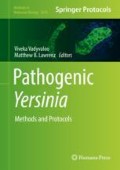Abstract
Early sensing of bacterial infection and the immediate recruitment of neutrophils to the lung is a major and decisive stage of the innate immune response to pulmonary bacterial infections. This chapter details the preparation of lung tissue suspensions from mice infected intra-nasally (I.N.) with the plague bacterium Yersinia pestis to study in vivo neutrophil responses to the infection. The samples were used for the quantification of neutrophil levels and for the characterization of the pro-inflammatory response required for neutrophil recruitment to the lung. The specific requirements for performing the procedures under Biosafety Level 3 containment and the proper handling and sterilization of the samples are discussed.
Access this chapter
Tax calculation will be finalised at checkout
Purchases are for personal use only
References
Craig A, Mai J, Cai S, Jeyaseelan S (2009) Neutrophil recruitment to the lungs during bacterial pneumonia. Infect Immun 77(2):568–575
Strieter RM, Kunkel SL (1994) Acute lung injury: the role of cytokines in the elicitation of neutrophils. J Invest Med 42(4):640–651
Williams MR, Azcutia V, Newton G, Alcaide P, Luscinskas FW (2011) Emerging mechanisms of neutrophil recruitment across endothelium. Trends Immunol 32(10):461–469. https://doi.org/10.1016/j.it.2011.06.009
Mocsai A (2013) Diverse novel functions of neutrophils in immunity, inflammation, and beyond. J Exp Med 210(7):1283–1299. https://doi.org/10.1084/jem.20122220
Perry RD, Fetherston JD (1997) Yersinia pestis--etiologic agent of plague. Clin Microbiol Rev 10(1):35–66
Inglesby TV, Dennis DT, Henderson DA, Bartlett JG, Ascher MS, Eitzen E et al (2000) Plague as a biological weapon: medical and public health management. Working Group on Civilian Biodefense. JAMA 283(17):2281–2290
Kool JL (2005) Risk of person-to-person transmission of pneumonic plague. Clin Infect Dis 40(8):1166–1172
Pechous RD, Sivaraman V, Stasulli NM (2016) GoldmanWE. Pneumonic plague: the darker side of Yersinia pestis. Trends Microbiol 24(3):190–197
Agar SL, Sha J, Foltz SM, Erova TE, Walberg KG, Parham TE et al (2008) Characterization of a mouse model of plague after aerosolization of Yersinia pestis CO92. Microbiology 154(Pt 7):1939–1948
Bubeck SS, Cantwell AM, Dube PH (2007) Delayed inflammatory response to primary pneumonic plague occurs in both outbred and inbred mice. Infect Immun 75(2):697–705
Lathem WW, Crosby SD, Miller VL, Goldman WE (2005) Progression of primary pneumonic plague: a mouse model of infection, pathology, and bacterial transcriptional activity. Proc Natl Acad Sci U S A 102(49):17786–17791
Price PA, Jin J, Goldman WE (2012) Pulmonary infection by Yersinia pestis rapidly establishes a permissive environment for microbial proliferation. Proc Natl Acad Sci U S A 109(8):3083–3088
Vagima Y, Zauberman A, Levy Y, Gur D, Tidhar A, Aftalion M, Shafferman A, Mamroud E (2015) Circumventing Y. pestis virulence by early recruitment of neutrophils to the lungs during pneumonic plague. PLoS Pathog 11:e1004893
Vagima Y et al (2012) Early sensing of Yersinia pestis airway infection by bone marrow cells. Front Cell Infect Microbiol 2:143
Cornelis GR, Wolf-Watz H (1997) The Yersinia Yop virulon: a bacterial system for subverting eukaryotic cells. Mol Microbiol 23(5):861–867
Viboud GI, Bliska JB (2005) Yersinia outer proteins: role in modulation of host cell signaling responses and pathogenesis. Annu Rev Microbiol 59:69–89
Zauberman A, Cohen S, Mamroud E, Flashner Y, Tidhar A, Ber R et al (2006) Interaction of Yersinia pestis with macrophages: limitations in YopJ-dependent apoptosis. Infect Immun 74(6):3239–3250
Spinner JL, Cundiff JA, Kobayashi SD (2008) Yersinia pestis type III secretion system-dependent inhibition of human polymorphonuclear leukocyte function. Infect Immun 76:3754–3760. https://doi.org/10.1128/IAI.00385-08
Pechous RD et al (2013) Early host cell targets of Yersinia pestis during primary pneumonic plague. PLoS Pathog 9:e1003679
Chung LK, Bliska JB (2016) Yersinia versus host immunity: how a pathogen evades or triggers a protective response. Curr Opin Microbiol 29:56–62
Stasulli NM, Eichelberger KR, Price PA, Pechous RD, Montgomery SA, Parker JS, Goldman WE (2015) Spatially distinct neutrophil responses within the inflammatory lesions of pneumonic plague. MBio 6:e01530–e15
Author information
Authors and Affiliations
Corresponding author
Editor information
Editors and Affiliations
Rights and permissions
Copyright information
© 2019 Springer Science+Business Media, LLC, part of Springer Nature
About this protocol
Cite this protocol
Vagima, Y., Levy, Y., Mamroud, E. (2019). Monitoring of Neutrophil Recruitment to Mice Lungs During Pneumonic Plague. In: Vadyvaloo, V., Lawrenz, M. (eds) Pathogenic Yersinia. Methods in Molecular Biology, vol 2010. Humana, New York, NY. https://doi.org/10.1007/978-1-4939-9541-7_10
Download citation
DOI: https://doi.org/10.1007/978-1-4939-9541-7_10
Published:
Publisher Name: Humana, New York, NY
Print ISBN: 978-1-4939-9540-0
Online ISBN: 978-1-4939-9541-7
eBook Packages: Springer Protocols

